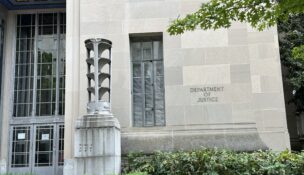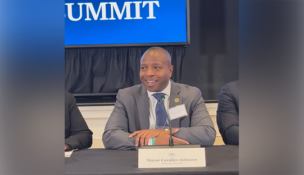Courts brace for sequester fallout
By: Rick Benedict//March 26, 2013//
By Kimberly Atkins and Barbara Jones
Dolan Media Newswires
 Delays in case processing, less supervision of criminal offenders, long lines due to a shortage of security personnel at courthouses and court employee layoffs are just a few of the things the federal court system is bracing for as a result of the ongoing automatic federal budget cuts known as the budget sequester.
Delays in case processing, less supervision of criminal offenders, long lines due to a shortage of security personnel at courthouses and court employee layoffs are just a few of the things the federal court system is bracing for as a result of the ongoing automatic federal budget cuts known as the budget sequester.
From administrative offices at trial-level courts to the courtroom of the U.S. Supreme Court, the effect of the deep budget cuts will be felt throughout the federal court system until Congress passes a measure to fully fund the federal government, officials said.
“These actions are unsustainable, difficult and painful to implement,” 6th U.S. Circuit Judge Julia Gibbons told the Judicial Conference of the United States, the policymaking body for the federal court system, at its biannual meeting in Washington, D.C., recently. “The judiciary cannot continue to operate at sequestration funding levels without seriously compromising the constitutional mission of the federal courts.”
The budget sequester, which began March 1 after Congress and White House officials failed to reach a deficit reduction deal under the Budget Control Act, will force $85 billion worth of cuts in 2013 absent congressional action. About $350 million of those cuts will affect the federal judicial system.
The looming funding crisis was the main focus of members of the House Appropriations Committee when Supreme Court Justices Anthony Kennedy and Stephen Breyer testified on judicial oversight last week.
“Yes, trials would be delayed. Yes, bankruptcies would be delayed,” Kennedy told members of the committee. “And if you slow that down, you slow down civil dispositions of contracts waiting to be enforced [and decisions on] whether a plant’s going to be built or so forth, whether damages are going to be paid to someone who was the victim of a breach of contract, if you’re going to potentially cause dismissal [of] criminal prosecutions. You are threatening the efficiency of the legal structure.”
Deep cuts looming
While all three branches of the federal government will be affected by the ongoing automatic spending cuts if no solution is found soon, judiciary officials said the implications for the court system will be particularly palpable because it is largely people-driven. If the sequester extends past the middle of the year, the judiciary’s budget offers little wiggle room, so furloughs and layoffs will be inevitable, officials said.
As a result, court operations will be affected in five major areas, according to the Administrative Office of the U.S. Courts:
- Public safetyFewer probation officers and other critical personnel will mean less supervision of criminal offenders released into the community, as well as reduced access to drug testing and mental health treatment.
- Delays in case processingSharp staff reductions for clerks’ offices will mean court officials will have to place a priority on criminal cases. As a result, expect significant delays in the processing of civil and bankruptcy cases, which could have an adverse effect on the overall economic recovery.
- Court securityFunding for court security systems will be cut by 30 percent, meaning court security officers will work fewer hours, leaving court security systems more vulnerable.
- Federal defendersFederal public defenders will face layoffs and furloughs, which could result in delays in defense counsel appointment. Attorneys appointed pursuant to the Criminal Justice Act could see their payments delayed.
- Information technologyThe IT programs that courts depend on for daily case processing will see deep cuts.
“Reductions of this magnitude strike at the heart of our entire system of justice and spread throughout the country,” said Gibbons, chairwoman of the conference’s budget committee. “The longer the sequestration stays in place, the more severe will be its impact on the courts and those who use them.”
‘This is serious business’
Kennedy and Breyer, testifying before Congress, stressed that the judiciary system has already focused on cutting costs over the past several years, given the already tightening budgetary issues facing the government. Asking for more cuts will affect all aspects of court operations.
“We have some policemen who are there for security purposes who don’t just protect us, but they protect the public,” Breyer told lawmakers.
“And then we have to keep the courtroom reasonably clean. And if you didn’t keep it clean, it’s not just us again who would suffer. Even the litigants.”
Kennedy said he asked his clerks to find out how many Supreme Court opinions and transcripts were downloaded last year.
“And the answer — I was astounded myself — is just under 70 million downloads,” Kennedy said. “That’s the education function that we’re performing. And we have to have technical staff that can perform this function.”
Because the funding structure of the federal judiciary is decentralized, the effect of the sequester will vary from court to court.
However, Kennedy said, history shows that major budget crises have had more serious effects on the criminal system.
“The first things that are cut when there’s an across-the-board cut in the expenditure for the courts are pretrial sentence officers and probation officers, and this is very dangerous,” Kennedy said. “And then public defenders are also on the list. … This is serious business.”
Chief Federal Public Defender Katherian Roe said the public defender situation is grave nationwide. It’s an ironic way to observe the recent 50th anniversary of Gideon v. Wainwright, she said, because budget cuts are seriously undermining the promise of Gideon.
Roe is part of the Defenders Services Advisory Group, made up of eight defenders who will recommend policy choices to the Office of Defender Services. “We’re not sure what we’re going to do. We might have a clawback [of funds] or we might have local solutions,” she said.
A significant number of public defender offices will have to furlough their entire staff for 20 to 35 days, Roe said. Those furloughs will have to happen soon, before the end of the fiscal year. One office is looking at a 60-day furlough, she said.
Roe believes she will avoid furloughs. She’s moved money around to cover personnel costs and has already cut to the bone, she said. But the other districts in the country can’t just be shuttered, she said. “We may have to take from Minnesota and give to neighboring states,” she said.
Legal News
- Some State Bar diversity participants walk away from program
- Wisconsin court issues arrest warrant ‘in error’ for Minocqua Brewing owner
- Iranian nationals charged cyber campaign targeting U.S. Companies
- Facing mostly white juries, are Milwaukee County defendants of color truly judged by their peers?
- Milwaukee Mayor speaks in D.C. Tuesday at White House water summit
- Chicago man sentenced to prison after being caught with ‘Trump Gun’
- FTC bans non-competes
- Gov. Evers seeks applicants for Dane County Circuit Court
- Milwaukee man charged in dismemberment death pleads not guilty
- Democratic-led states lead ban on the book ban
- UW Madison Professor: America’s child care crisis is holding back moms without college degrees
- History made in Trump New York trial opening statements
WLJ People
- Power 30 Personal Injury Attorneys – Russell Nicolet
- Power 30 Personal Injury Attorneys – Benjamin Nicolet
- Power 30 Personal Injury Attorneys – Dustin T. Woehl
- Power 30 Personal Injury Attorneys – Katherine Metzger
- Power 30 Personal Injury Attorneys – Joseph Ryan
- Power 30 Personal Injury Attorneys – James M. Ryan
- Power 30 Personal Injury Attorneys – Dana Wachs
- Power 30 Personal Injury Attorneys – Mark L. Thomsen
- Power 30 Personal Injury Attorneys – Matthew Lein
- Power 30 Personal Injury Attorneys – Jeffrey A. Pitman
- Power 30 Personal Injury Attorneys – William Pemberton
- Power 30 Personal Injury Attorneys – Howard S. Sicula











